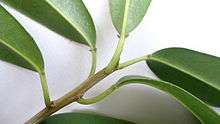Sapium
| Milktrees | |
|---|---|
 | |
| Sapium glandulosum | |
| Scientific classification | |
| Kingdom: | Plantae |
| Clade: | Angiosperms |
| Clade: | Eudicots |
| Clade: | Rosids |
| Order: | Malpighiales |
| Family: | Euphorbiaceae |
| Subfamily: | Euphorbioideae |
| Tribe: | Hippomaneae |
| Subtribe: | Hippomaninae |
| Genus: | Sapium Jacq. 1760,[1] conserved name, not Sapium P. Browne 1756[2] |
| Synonyms[3] | |
Sapium is a genus of flowering plants in the family Euphorbiaceae.[4][5] It is widespread across most of Latin America and the West Indies.[3][6] Many Old World species were formerly included in the genus, but recent authors have redistributed all the Old World species into other genera.[7]
Species are known commonly as milktrees.[8]
Description
These are shrubs and trees. They produce latex. The leaves are alternately arranged and smooth-edged or toothed. They are monoecious, often with spikelike or raceme-shaped inflorescences that have several male flowers, plus a few female flowers near the base. The male flowers have 2 to 4 stamens. The female flowers have 2 to 4 styles which are sometimes coiled. The flowers lack petals. The fruit has 2 to 4 lobes and may split open or not.
- Species[3]
- Sapium adenodon - Cuba
- Sapium allenii - Costa Rica
- Sapium argutum - Fr Guiana, Suriname, Amapá, Fernando de Noronha
- Sapium ciliatum - Fr Guiana, Suriname, Pará
- Sapium cuneatum - Jamaica
- Sapium daphnoides - Cuba, Hispaniola
- Sapium glandulosum - Mexico, West Indies, Central + S America to Uruguay
- Sapium haematospermum - Brazil, Bolivia, Paraguay, N Argentina, Uruguay
- Sapium haitiense - Massif de la Hotte
- Sapium jenmannii - Guyana, Venezuela, Colombia, NW Brazil; naturalised in Trinidad
- Sapium lateriflorum - C + S Mexico, Central America
- Sapium laurifolium - Chiapas, Greater Antilles, Central America, NW South America
- Sapium laurocerasus - Puerto Rico
- Sapium leucogynum - Cuba
- Sapium macrocarpum - Mexico, Central America
- Sapium marmieri - Bolivia, Peru, Ecuador, Colombia, NW Brazil
- Sapium obovatum - Brazil, Bolivia, Paraguay
- Sapium pachystachys - Nicaragua, Costa Rica, Panama
- Sapium pallidum - Bahia, Minas Gerais
- Sapium parvifolium - Cuba
- Sapium paucinervium - NE South America
- Sapium sellowianum - Minas Gerais, São Paulo
- Sapium stylare - Costa Rica, Panama, Venezuela, Colombia, Ecuador
- formerly included
over 200 names moved to other genera: Alchornea, Anomostachys, Antidesma, Conosapium, Excoecaria, Gymnanthes, Hippomane, Microstachys, Sclerocroton, Sebastiania, Shirakiopsis, Spirostachys, Stillingia, Triadica, etc.
References
| Wikimedia Commons has media related to Sapium. |
| Wikispecies has information related to: Sapium |
- ↑ "Sapium Jacq.". Germplasm Resources Information Network. United States Department of Agriculture. 2007-10-05. Retrieved 2010-08-11.
- ↑ Tropicos, search for Sapium
- 1 2 3 Kew World Checklist of Selected Plant Families
- ↑ Jacquin, Nicolaus Joseph von. 1790. Enumeratio Systematica Plantarum, quas in insulis Caribaeis 9, 31 in Latin
- ↑ Tropicos, Sapium Jacq.
- ↑ Govaerts, R., Frodin, D.G. & Radcliffe-Smith, A. (2000). World Checklist and Bibliography of Euphorbiaceae (and Pandaceae) 1-4: 1-1622. The Board of Trustees of the Royal Botanic Gardens, Kew.
- ↑ Kruijt, R. C. (1996). A taxonomic monograph of Sapium Jacq., Anomostachys (Baill.) Hurus., Duvigneaudia J. Léonard and Sclerocroton Hochst. (Euphorbiaceae tribe Hippomaneae). Biblioth. Bot. 146, 1-109.
- ↑ Sapium. Integrated Taxonomic Information System (ITIS).